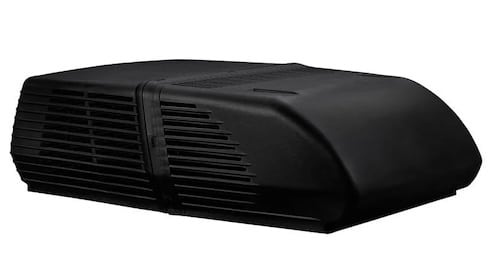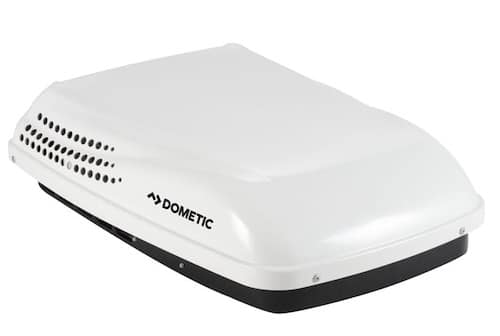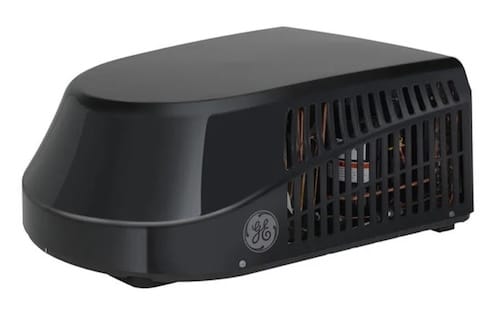Your RV roof air conditioner is one of the most essential appliances for climate control, especially if you camp in the spring or summer. It’s the reason most campers ultimately upgrade from tent camping to RVing. Whether you want to replace, add, or upgrade your RV air conditioner, we’re here to help.
Learn everything you need to know about RV air conditioners, from choosing the right size to ensuring you have all the correct parts.
Key Takeaways
- RV air conditioners come in several types: roof-mounted (ducted or non-ducted), window, and portable units. Each has pros and cons based on cooling power, installation, space, and efficiency.
- Choosing the right RV A/C depends on factors such as RV size, BTU rating, power source, brand compatibility, thermostat type, and desired extra features (e.g., heat pump, soft start, condensate pump, etc.).
- Top rooftop A/C models from Dometic, Furrion, Coleman-Mach, GE, and others offer varying cooling capacities, profiles, and features; proper generator sizing and optional A/C covers help optimize performance and longevity.
Table of Contents
ToggleTypes of RV Air Conditioners
The most popular type of air conditioner is an overhead RV A/C installed on the roof. This type blows air directly into the RV or distributes it through a ducting system. In recent years, we’ve seen an emergence of window and wall-mounted units, especially in smaller RVs. While less common, portable RV air conditioners can also be found in modern RVs.
Need help determining which is best for you? Let’s review the best RV air conditioners by type.
RV Roof Air Conditioners

The most popular, and for good reason, RV roof air conditioners don’t take up any space inside the RV. They are the most effective at distributing air, especially in a ducted system. These units provide the most efficient cooling, and many can also deliver heat if you have a model with a heat pump or strip. Although leading the charts in performance, they also lead the charts in power draw and replacement cost.
| Pros | Cons |
| Powerful | Expensive to Replace |
| Don’t Take Up Interior Space | Large Power Draw |
| Heat Pump Option | Adds to Overall RV Height |
Ducted versus Non-Ducted RV A/C Units
There are two types of roof-mounted A/C units: ducted and non-ducted. In a ducted system, ducts run through the RV’s floor, walls, or ceiling, and vents deliver the air throughout the floor plan.
A non-ducted system has only one vent at the distribution box. Air blows straight down from the unit into the RV. Non-ducted systems are standard for small RVs, while ducted systems are common in larger RVs with multiple rooms.
Distribution boxes are usually specific to ducted or non-ducted RVs, so you’ll need to know which type you have before selecting one.
RV Window A/C Units

One issue with using an overhead air conditioner on a small camper is the potential to freeze you. Most manufacturers consider a small RV air conditioner to be 13,500 BTU, which is too much for a small RV, even on the lowest setting. With a smaller RV, you also likely have a more limited power supply, and window units draw about half as much power as an overhead A/C, on average.
| Pros | Cons |
| Won’t Freeze You Out | Takes Up Wall Space |
| Smaller Power Demand | Unsightly |
| No Addition to RV Height | Less Efficient Cooling |
Portable RV Air Conditioners

A portable air conditioner is most likely used in an RV to supplement a roof or wall-mounted unit. Its downsides include reduced cooling capacity, added setup time, and reduced storage space. However, it also has positives, such as quiet operation and less strain on your wallet.
Portable air conditioners are also an option for RVs without an air conditioner or a temporary A/C replacement. The best part is that adding one does not require significant modifications, like cutting into the roof or walls.
| Pros | Cons |
| Easy Install | Poor Efficiency |
| Easy to Move Design | Requires Setup |
| Cost Effective | Takes Up Storage Space |
How To Choose an RV Air Conditioner
The choice of an RV air conditioner can be overwhelming. There is an endless list of options and plenty of compatibility concerns. Let’s go over some common deciding factors to help you make a suitable choice.
Brand
There are two schools of thought behind choosing the right RV air conditioner brand. The first is choosing the same brand you have now to ensure compatibility. The second is choosing a different brand, with the expectation that you may have to replace multiple components to ensure everything works together. It’s a good idea to pick one that offers a system with the features you need. Here are some of the top RV air conditioner brands:
Size (BTU Rating)
When most people talk about an RV air conditioner’s size, they refer to its BTU rating. British Thermal Units, also known as BTUs, are essentially a measure of power. The higher the BTU rating, the greater its cooling capacity. Most manufacturers offer a smaller 13,500 BTU RV air conditioner and a larger 15,000 BTU RV air conditioner. There are some oddball ratings as well, such as 11,000 BTU for smaller RVs.
Several factors, such as the size of the RV, insulation properties, and number of rooms, must be considered when choosing the correct size (AKA BTU rating) for your RV. We recommend sticking with the manufacturer’s suggestion, which you can get by calling the manufacturer directly with your vehicle identification number (VIN).
If your camper did not come with an air conditioner and you want to add one, you can use the general size chart below as an estimate.
| RV Length | BTU Requirement |
| <20 | 13,500 |
| 20-30 | 15,000 |
| >30 | 27,000-30,000 |
Manual or Electric
A manual system is controlled via the distribution box, so you must adjust settings directly on the ceiling or wall-mounted RV air conditioner. This may pose an issue if you’re shorter or have a high ceiling.
An electric system uses a wall-mounted thermostat for operation. Although most prefer a wall thermostat, manual systems are easier to install because you don’t have to run wires through the walls and ceiling.
Features
There are many features to consider, but not all brands offer the same options. It’s smart to select only what you need. Generally, the more features it has, the more expensive it will be. A few examples of standard features are listed below:
- Heat Pump – Provides extra heat in colder months. Works best above 40 degrees Fahrenheit.
- Heat Strip – Designed to remove the chill, it should not be a primary heat source.
- Soft Start – Reduces start-up energy demands, allowing for a smaller generator.
- Condensate Pump – Channels condensation away from the roof and out a drain tube.
- RV Air Conditioner Soft Starter – Reduces the amount of power needed to start your A/C. Great for boondocking.
Best RV Air Conditioner Models to Consider
Our top-rated RV air conditioners will help you find a reliable system to keep you cool this summer.
Dometic FreshJet 3 Series RV Air Conditioner

The most innovative rooftop air conditioner on the list is a Dometic RV air conditioner, the FreshJet 3. The FreshJet offers upgraded efficiency, quieter operation, and e-coated coils for added durability.
| Profile Height (in.) | Weight (lbs) | Rating (BTUs) |
| 13.8” | 64-66 | 13,500 or 15,000 |
Furrion Chill HE RV Roof Air Conditioner

The Furrion Chill is a highly efficient rooftop air conditioner with durable features like vibration protection and a thermal-insulated shroud.
| Profile Height (in.) | Weight (lbs) | Rating (BTUs) |
| 13.5” | 82-93 | 13,500 or 15,000 |
Coleman Mach Quiet Series 15 Air Conditioner

The Coleman Mach is one of the most tried-and-true RV rooftop air conditioners. This high-performance air conditioner offers superior cooling and unrivaled durability.
| Profile Height (in.) | Weight (lbs) | Rating (BTUs) |
| 13.8” | 83.5 | 15,000 |
Dometic Penguin II High-Capacity Air Conditioner

What’s unique about the Penguin is its low-profile design, which improves aerodynamics and helps cut down on fuel costs. Pair this with a high-performance motor for maximum cooling power, and you have an excellent rooftop RV air conditioner.
| Profile Height (in.) | Weight (lbs) | Rating (BTUs) |
| 11.25” | 101 | 13,500 |
GE R32 Deluxe RV Air Conditioner

The GE air conditioner is cost-effective and reliable. It has rubber grommets to reduce vibrations, a glossy shroud to increase aesthetics, and easy-to-maintain coils for cleaning.
| Profile Height (in.) | Weight (lbs) | Rating (BTUs) |
| 13.9” | 80 | 13,500 |
What Are the Different Rooftop Air Conditioner Components?
RV roof air conditioning systems are a collection of components that work together to deliver cool air throughout your camper. The main element is your roof-mounted unit, followed by the distribution box, a control module, and the thermostat. Some units come as a kit with all the needed items, whereas others require you to purchase them separately. Here’s how each component in the system functions:
The A/C Unit

The main component of an air conditioner for RV roofs is the unit itself. The unit contains all the internal air conditioning parts, such as the coils, condenser, compressor, etc.
Distribution Box

The distribution box is mounted inside the RV to the ceiling directly below the A/C unit. It distributes air throughout the RV through one or multiple vents.
Control Module
The control module is mounted to the distribution box or inside the unit. It controls all the settings, such as air speed and temperature. It is the system’s brain that communicates with the A/C unit, distribution box, and thermostat.
Thermostat

The thermostat tells the A/C unit when to turn on/off. It can be mounted on the wall (electric) or to the distribution box (manual).
Shroud

The shroud protects the internal components of the A/C unit. Typically constructed of polypropylene, these covers are durable and weather-resistant.
Air Filter
The air filter is installed inside the distribution box in front of the vent. It blocks allergens, such as dust, pollen, mold spores, and more, from entering the RV.
What Size Generator Do I Need for My Air Conditioner?

Generally, most 13,500 BTU RV air conditioners will require at least 3,500 starting watts, and 15,000 BTU RV air conditioners will need upwards of 4,000 starting watts.
When camping off-grid, there’s no access to shore power. Air conditioners draw too much power for your batteries, forcing you to use a portable RV generator. Unfortunately, generator sizing can be tricky. Due to space, weight, and fuel concerns, you’ll usually want to use a generator that is as small as possible.
Like generators, most air conditioners have running and starting wattage requirements. Starting watts represent how much power the unit requires on startup, and running watts represent how much power it needs to stay running. The starting watts can be almost double the running watts. An A/C soft start can reduce the power starting requirements.
Learn more in this generator sizing guide.
Do I Need An Air Conditioner Cover?
If you don’t have an RV cover, a rooftop air conditioner cover is noteworthy for protecting the assembly when your RV is in storage. Use an air conditioner cover to prevent dust, debris, moisture, and other potentially damaging substances from negatively impacting your vital components.
Use these additional resources to learn more, upgrade, or troubleshoot:
- Top RV Air Conditioner FAQs
- How To Improve A/C Efficiency
- RV Air Conditioner Maintenance Tips
- Why Is My RV AC Dripping Water Inside?
Let us know what RV air conditioner unit you prefer or if you have any questions in the comments below.
Author
-

Conner Lund is a Technical Content Writer. He has both hands-on experience and real-world knowledge. He’s an avid outdoorsman: camping, hiking, backpacking, mountain biking, kayaking, hunting, and fishing are all things he enjoys that you could find him doing on any given weekend. He loves to travel and see new places. He does most of his exploring and camping out of his overlanding truck with a rooftop tent.
View all posts









Hi my ac unit is damaged I am looking to replace the unit but I don’t know what unit to buy, I have a 2010 travel lite m-700 standard. Can you point me to the right one.
Hi Alexander!
I’d recommend contacting the Service Department at your local Camping World (https://rv.campingworld.com/rv-collision-renovation). They’ll likely need a make/model for the AC unit itself to help identify a compatible replacement, but could also provide a quote for the removal and replacement if you’re interested. Hope that helps!